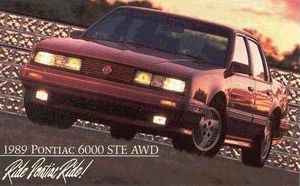.
Pontiac 6000

| |
| Pontiac 6000 | |
|---|---|
| Pontiac | |
| Production | 1982-1991 |
| Class | Intermediate |
| Body Style | 2-Door Coupe 4-Door Sedan 5-Door Wagon |
| Length | 188.9" |
| Width | 72" |
| Height | 53.7" |
| Wheelbase | 104.9" |
| Weight | 3100-3400 lbs |
| Transmission | 3-Speed Automatic, FWD/AWD 4-Speed Automatic, FWD 5-Speed Manual |
| Engine | 2.5L (151 cid) I4 (1982-1991) 2.8L (173 cid) V6 (1982-1989) 3.1L (191 cid) V6 (1988-1991) 4.3L (262 cid) Diesel V6 (1982-1985) |
| Power | 90-140 hp |
| Similar | Buick Century Chevrolet Celebrity Oldsmobile Cutlass Ciera |
| Platform | A |
Pontiac introduced the A-body 6000 in 1982 as a replacement for the departed rear-drive LeMans, and was built on the same 104.9" front wheel drive X-body Phoenix chassis and drivetrain. The 6000 was offered along with its corporate mates, the Buick Century, Chevrolet Celebrity and Oldsmobile Cutlass Ciera, and while those cars catered to a more conservative crowd, Pontiac fancied the 6000 as a quasi-alternative to Audi and BMW sport sedans - a lofty goal indeed. It would be offered thru the end of the 1991 model year.
Here's a quick rundown:
1982-1991
When the 6000 was first introduced in 1982, there we're coupe and sedan bodystyles, with two trim levels: base and LE. Both offered the Phoenix's standard 2.5L Iron-Duke four cylinder engine, using throttle body injection, and produced 90 horsepower and 125 lb/ft of torque. Optional was GM's 2.8L V6 engine, using a 2-barrel carburetor, producing 112 horsepower and 135 lb/ft of torque, as well as an optional 4.3L Diesel V6 supplied by Oldsmobile, producing 83 horsepower. A 3-speed automatic transmission was the sole transmission option.
For 1983, the base and LE models we're accompanied by a new STE model. The STE was designed to take on fine European road cars from Audi, BMW and Mercedes-Benz, for about half the cost. Standard was a high output 2.8L V6 sporting a 2-barrel carburetor. This engine produces 135 horsepower and 165 lb/ft of torque, with a standard floor mounted 3 speed automatic transmission. The STE sets itself apart from other 6000s by offering a unique front fascia with integrated fog lamps for a 6 headlamp look. At the rear, a full width lightbar enhanced it's euro-sedan look. Underneath, an upgraded suspension, wider and stickier tires and a mellow exhaust gave the STE the European feel. Inside, the STE used wider and more supportive bucket seats with available 8-way power adjustment for both driver and front passenger seats, an upgraded stereo and a driver information center. However, the STE still used the basic 6000-style dash which, along with the carbureted engine (most European sedans featured Fuel Injection), made the STE seem rather deficient when compared to it's intended competition. For 1984, a wagon was added to all models save the STE, and the STE featured a digital dashboard featuring full instrumentation.
In 1985, the STE's high-output V6 now sported multi-port fuel injection, increasing horsepower to 140 and torque to 170 lb/ft. The 2.5L engine had an increase in horsepower to 92, and got a standard 4 speed manual transmission. The 2.8L V6 was also available with the manual transmission. In 1986, the diesel engine was dropped and all remaining engines we're fuel injected. A 4 speed automatic transmission was available with the 2.8L V6. The STE model also now featured composite headlamps, a further upgraded stereo with innovative steering wheel controls (a Pontiac innovation that would later make it's way onto almost every car today) and Anti-Lock Brakes. In 1987, all 6000s received new front ends with composite headlamps, the 2.5L engine got an increase in horsepower to 98, an SE model was added with much of the STE styling and powertrain, but less standard equipment and the STE now features a memory for the driver's seat.
For 1988, all-wheel-drive was added as an option for the STE, with the addition of a new engine. When all-wheel-drive was ordered, the 2.8L was replaced by a 3.1L V6 producing 140 horsepower and 185 lb/ft of torque. Although the front-wheel-drive version used a 4 speed automatic, the all-wheel-drive version only used a 3 speed automatic. In 1989, the STE was only offered with all-wheel-drive, and mid year the 2.5L gained balance shafts and an increase in horsepower to 110. The rear window of all 6000s was redesigned with a rounder look. For 1990, the STE trim was dropped and moved to the Grand Prix sedan, and the SE model inherited the AWD option, and the 2.8L V6 was dropped as the 3.1L expanded to front-wheel-drive 6000 models, with an available 4 speed automatic. For 1991, the SE and AWD models we're dropped. The 6000 didn't return for the 1992 model year.
